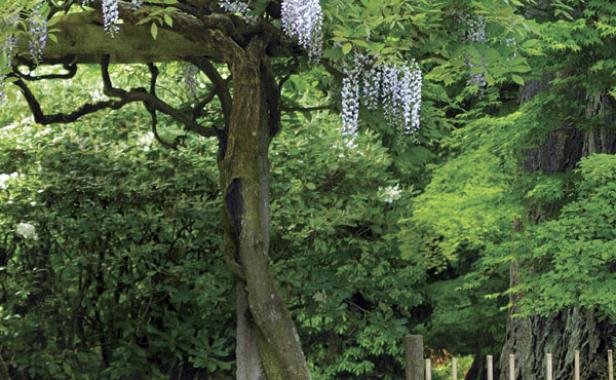
While searching for my first apartment in Brooklyn, I was shown a one bedroom on a quiet, tree-lined street. The apartment itself wasn’t memorable, but the building was: The entire brownstone was encased by an impenetrable mass of wisteria, windows and all. Covering a three-story building is no challenge for some vigorous wisteria vines, which are able to grow 10 feet or more in a single season. Yet for all its rampant behavior, a wisteria in full bloom is one of the loveliest sights.
Wisteria can live a long, healthy life with no pruning at all, happily twining, climbing, and sprawling over everything in its path. But for the gardener who has limited space and wants to enjoy more visible and abundant wisteria flowers, a pruning routine becomes a necessary chore. For optimal results, plan for at least a biannual (once in summer, once in winter) pruning regimen. Knowing how the vine grows will also aid in your success.
Living without windows is not for everybody, but with some initial planning and a commitment to regular pruning, no one has to.
Summer: Cut the long shoots after flowers fade
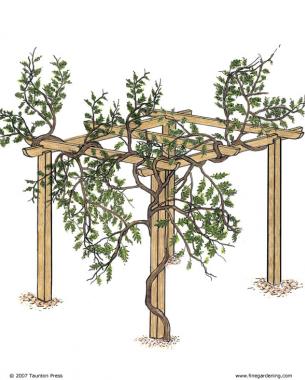
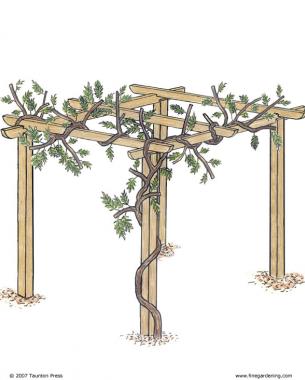
Since wisteria flowers develop on the previous year’s growth, pruning wisterias biannually not only keeps these vigorous vines to a manageable size but also creates a system of short branches close to the structure, where you can more easily enjoy the blooms. To accomplish this, simply prune the long shoots of the current year’s growth back to 6 inches long in early summer after the vines have flowered. Also at this time, completely remove any shoots not needed for the main framework of the plant and prune away root suckers, especially on grafted varieties. This type of pruning may be done once a summer or more frequently, depending on how much time you have and how neat you want your vine to look. Keep in mind that many gardeners find wisteria seedpods decorative, so you many want to leave some spent flowers behind.
Design Tip
Some seedpods may be left on the vine for winter interest, but just know that if you bring them inside, warm temperatures will cause them to explode. A friend once used the pea-shaped fruit in a winter arrangement. The next morning, she found her cat crouched in the corner, hiding from the flying seeds.
Winter: Prune long shoots down to three or five buds
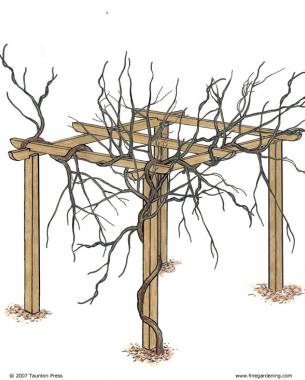
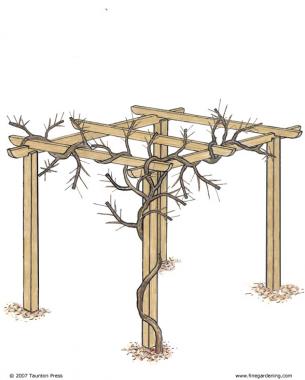
In late winter, prune the long shoots that have grown since the summer pruning down to three to five buds. Also remove any of last season’s unwanted long shoots, which will be more apparent now because the leafless framework will be exposed.
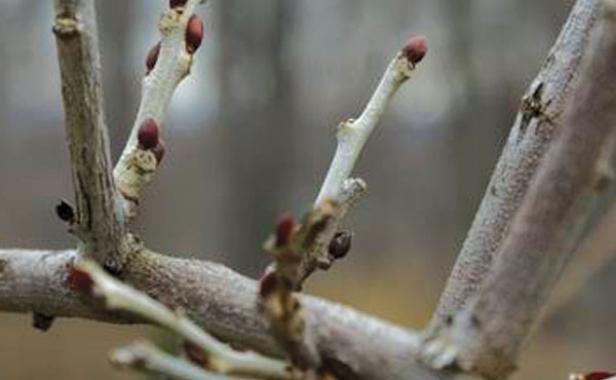
Why your wisteria may not bloom
Wisterias are notorious for failing to bloom. Before trying drastic measures, make sure these basic cultural requirements are met.
Seed-grown plants
The most common reason for lack of flowers is the selection of a seedgrown plant over a grafted plant. Grafted plants typically bloom within three years, while seed-grown vines may take upwards of seven years before flowering— if ever.
Light requirements
Wisterias need at least six hours of sunlight per day.
Exposure
Late frosts and high winds may damage flower buds, especially those of Wisteria sinensis. Conversely, wisterias bloom best after years with hot summer temperatures.
Fertilizer
Avoid high-nitrogen fertilizer. Like other legumes, wisteria fixes nitrogen in the soil. Too much nitrogen can cause excessive foliage growth and poor flowering.
Training a new wisteria on a pergola
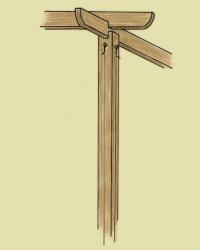
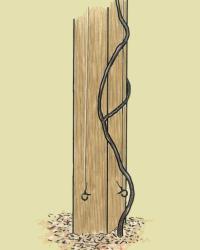
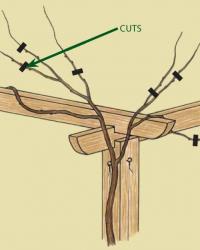
The vigor of the plant makes it adaptable to many forms. Wisteria may be shaped into a shrub or standard, trained against a building or lattice, or grown on a pergola or arbor. Wisteria floribunda is a desirable selection to grow on pergolas and arbors because its long flowers hang dramatically through the top. Only one plant is usually needed to cover an entire structure since it is, like other species of wisteria, such a vigorous grower. Planting two vines at opposite ends,however, gives a structure visual balance and affords a gardener the opportunity to feature two different cultivars on the same structure.
Start with a sturdy structure
Training wisteria to grow on a pergola or arbor is a practice that requires careful planning. In order to successfully use these structures, they must be made of a stout, weather-resistant material like cedar and set securely in the ground with concrete footings. Wisteria is infamous for pulling down its supports, so don’t be afraid to overbuild a pergola or arbor. I recommend that the posts be made of 4×4 lumber and the crosspieces of 2×4 lumber at least.
Train vines to climb
To begin training a new plant onto a pergola or arbor, allow two or three young shoots to twine loosely around each other and the post as they grow. This will help to provide added interest to the plant’s structure, since the woody stems become contorted and picturesque with maturity. The young shoots need to be secured to the post as they climb. To do this, attach a 14-gauge galvanized (or similar) wire using eye hooks, spaced about 18 inches apart, along two opposite sides of the post (or on all four sides for extra support). As the shoots grow, tie them as needed to the wire using gardening twine. Allow some slack as they grow to create a more attractive habit and to prevent the plant from putting heavy tension on the structure as the plant matures.
Encourage branching
Once the shoots have reached the top of the arbor, head them back (prune off the tips) to encourage side shoots, which will spread across the top of the supports and produce flowers. As the plant grows and becomes more stable across the top of the structure, the training ties on the post will become unnecessary. It’s a good idea to remove them to prevent the plant from being girdled as it grows.
Want to plant wisteria in your garden?
Learn more about wisteria species in Fine Gardening‘s Plant Guide:
Wisteria floribunda (Japanese wisteria)
Wisteria frutescens (American wisteria)
Wisteria sinensis (Chinese wisteria
Fine Gardening Recommended Products
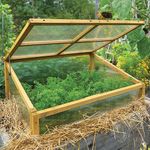
VegTrug Classic Cold Frame
Fine Gardening receives a commission for items purchased through links on this site, including Amazon Associates and other affiliate advertising programs.

SHOWA Atlas 370B Nitrile Palm Coating Gloves, Black, Medium (Pack of 12 Pairs)
Fine Gardening receives a commission for items purchased through links on this site, including Amazon Associates and other affiliate advertising programs.

Greenworks 40V (185 MPH / 340 CFM / 75+ Compatible Tools) Cordless Brushless Leaf Blower / Vacuum, 4.0Ah Battery and Charger Included
Fine Gardening receives a commission for items purchased through links on this site, including Amazon Associates and other affiliate advertising programs.

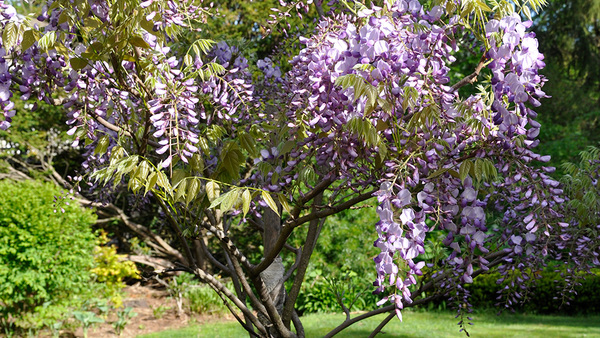
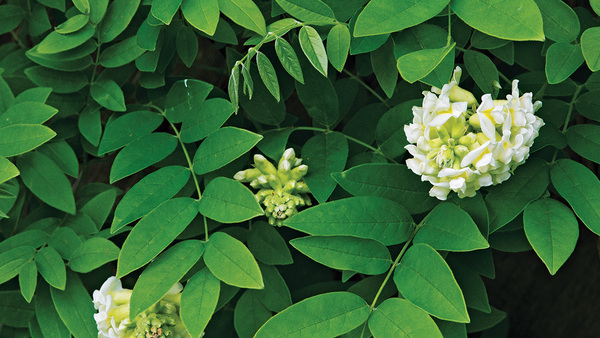
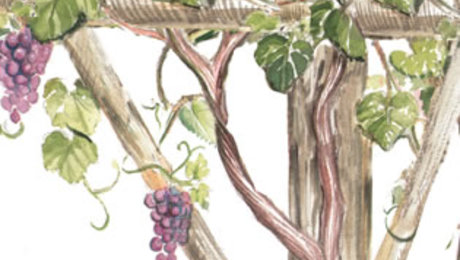
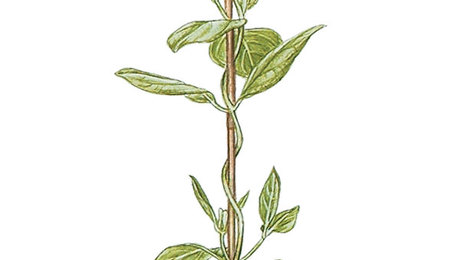













Comments
My wisteria is 3 years old and has never bloomed. When I bought it the lady said it would bloom in early spring. Now it looks like all the branches are dead. Is it suppose to look like that ?? I don't see any buds for a leaf or flower
Heard it takes up to 6 years to bloom
Very true
I wish you showed pictures of where to actually prune the wisteria shoots. I need a visual.
So my wisteria plants are brand new and I'm hoping to train them up our pergola- all these pics show giant trunk-like vines reaching all the way up to the top- how do I train all these short new bushy growths?
Ii lives in Orlando Florida and I found my wisteria plant in some woods of a friend property. I cut one of the running chute with a little bit of root (two chutes to be exactly) and it has done wonderfully. I do nothing to encourage growth but pruning in the winter months. I would love to train in to run on a pergola or trellis wall. How can I go about doing so since I have had it for 15 years or more? Oh yeah I got my blooms after 2 years.
I planted a small one, 3 yrs ago. 1st year, 2 blooms, 2nd year 4 blooms, 3rd year, it was covered with blooms.
Hello I was wondering if I should remove the pods from my wisteria at a certain time of the year or let them just pop and fall off?
I have a wisteria I made into a tree. It never bloomed for years then I had one bloom for two years in a row. Now I have no blooms again. I cut it back in the fall just because it gets so outrageous with trailing vines Any suggestions.
What I understood is that you need to prune the shoots in July.August to five buds - good luck in working your way through the bushes! - and then again in January.February where you prune the same shoots to two to three buds. This should allow your plant to create the thick 'wood' and concentrate its energy on producing flower buds. Also, don't provide too much nitrogen fertilizer (just in case), as that will stimulate vegetative growth, rather than bloom.
I started mine from seeds perlioned from a neighbors vine while walking my dog It took 5 years to bloom , about 6-7 flowers. I just instinctively kept nipping at overgrowth and cut away deadwood in fall and early spring. From what I read I'm lucky to have blooms that soon and somehow got the pruning right. Success from Buffalo NY!
Log in or create an account to post a comment.
Sign up Log in